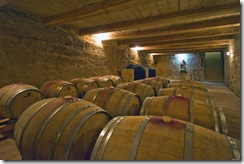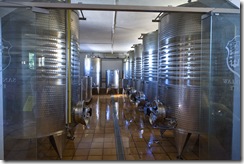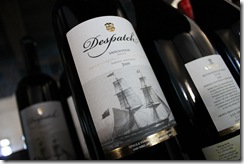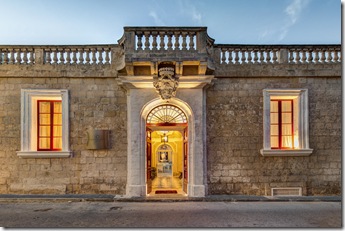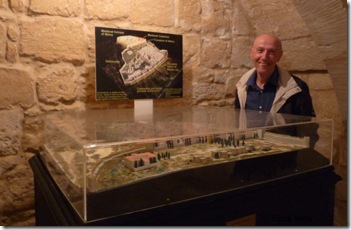Archive for the ‘Times of Malta’ Category
-
A Christmas Nursery
Even as a young child, Paul Pace was very fond of baby Jesus statues. Probably because they reminded him of a number of significant familial moments. His grandma gave him a small wax statue of baby Jesus in order to ease down his sorrow after his father George had to leave for a long time to work with the Navy. On another occasion, his father surprised him when he bought him an expensive statue of baby Jesus that he had longed for, after he succeeded to win a lottery. Now, at 69, Paul owns a collection of more than 2000 of such statues which he has lovingly gathered in a museum that he called ‘Il-Mużew tal-Bambini’.
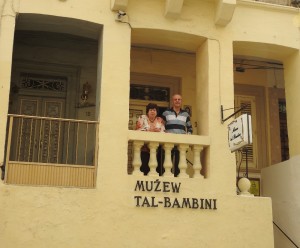 His wife Mary shares his passion and she is always present to give him a hand in this museum which they have purchased together.
His wife Mary shares his passion and she is always present to give him a hand in this museum which they have purchased together.“It is such a pleasure to see people getting emotional when they visit our museum. Some become very nostalgic as they remember their childhood. Others notice some statue which was similar to the one that their parents had, and they start recalling their memories. A number of visitors get inspired to buy a baby Jesus statue of their own, while some others decide to go home and search for their neglected antique statue which their grandma had left them,” Paul said.
Since its inauguration in 2010, il-Mużew tal-Bambini has become quite renowned both with the local and the foreign public. Although it is available for viewing by appointment throughout the year, most of the visitors attend to this museum during the Christmas season.
“There is always something new to see because we are continually adding to our collection. Even though by now, we have a problem with space, when we find a particular baby Jesus statue which we love, we just can’t help not to own it,” admitted Mary.
Certainly, the museum is a wonder to behold. The provenance of the statues is worldwide, thereby providing a rich overview of the different cultures. Skin colour, facial characteristics, and posture of these statues vary accordingly.
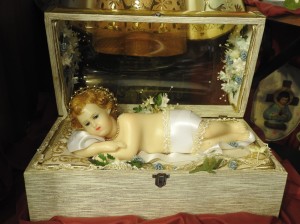 A delicate looking baby Jesus which was made in Malta, rests in a musical box and moves his eyes and hands. A dark skinned baby Jesus made from wood in Tanzania looks exotic amongst the others. A curly black-haired toddler Jesus, wearing the traditional costume of Perù, sits on a chair and weeps after stepping on a thorn, according to a local legend. A wooden statue from Betlehem shows Jesus as a boy dressed as a king and sitting on an elegant throne. A teenage Jesus from Atocia is also resting on a chair, but this time, he wears the clothes of a pilgrim and carries a rod. An intricately adorned statue of Jesus from Trapani is embellished with pomegranate for good luck.
A delicate looking baby Jesus which was made in Malta, rests in a musical box and moves his eyes and hands. A dark skinned baby Jesus made from wood in Tanzania looks exotic amongst the others. A curly black-haired toddler Jesus, wearing the traditional costume of Perù, sits on a chair and weeps after stepping on a thorn, according to a local legend. A wooden statue from Betlehem shows Jesus as a boy dressed as a king and sitting on an elegant throne. A teenage Jesus from Atocia is also resting on a chair, but this time, he wears the clothes of a pilgrim and carries a rod. An intricately adorned statue of Jesus from Trapani is embellished with pomegranate for good luck.“Our interest in this aspect has led us to travel to countries which are related to the life of Jesus, and from which we knew that we could find such statues. Our visit to the Holy Land was an incredible experience which gave us the opportunity to walk in the same roads where Jesus lived. Moreover, it was an ideal country from where to acquire some beautiful statues for our collection,” remarked Paul.
“When we visited Prague, we bought 42 different baby Jesus statues!” exclaimed Mary.
 They just had to, they explained, as they saw my startled reaction. This was because according to an old tradition, the statue of baby Jesus in Prague is dressed in different coloured clothes each day. Therefore, they were bound to purchase a number of statues which showed Jesus in several dresses. Nevertheless, not all the statues bought ended up in the museum, since some of these were presents for family members and friends.
They just had to, they explained, as they saw my startled reaction. This was because according to an old tradition, the statue of baby Jesus in Prague is dressed in different coloured clothes each day. Therefore, they were bound to purchase a number of statues which showed Jesus in several dresses. Nevertheless, not all the statues bought ended up in the museum, since some of these were presents for family members and friends.“Many of those who visit our museum are curious to know whether we can remember all our statues, which of course, we do. We can also recall all the places from where we have obtained these items. Each statue has an interesting story behind it and we love to share them with whoever’s interested to listen,” Paul said.
I was all ears and I felt simply fascinated when their narrative started to pour in. One of these stories entailed how they managed to buy a statue of baby Jesus which belonged to St. Ġorġ Preca. Another was related to an excellent bargain which Mary made unknowingly, when she bought a statue for her husband for a low price, and then found out that it dated to the 18th century. I loved also the account relating to a particular container made of mica which was produced in Malta by a German prisoner of war during World War II, and was utilized to hold a statue of baby Jesus.
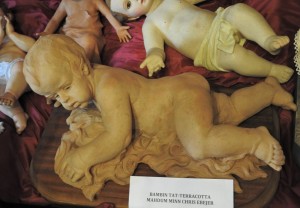 “We have many antique statues but the oldest one that we know the date of goes back to 1730. The smallest statue is about 15mm long, whereas the largest one has a length of 80cms. The materials of these statues varies widely and include: stone, alabaster, marble, woods of different kinds, wax, ceramic, concrete, lava, straw, plastic, wool, and even bull’s horn,” Mary explained.
“We have many antique statues but the oldest one that we know the date of goes back to 1730. The smallest statue is about 15mm long, whereas the largest one has a length of 80cms. The materials of these statues varies widely and include: stone, alabaster, marble, woods of different kinds, wax, ceramic, concrete, lava, straw, plastic, wool, and even bull’s horn,” Mary explained.Yet the strangest was yet to come…
“One day, we had a statue which lost its synthetic hair and we decided to try to replace it with some hair of one of our daughters. The experiment succeeded and soon, we provided the hair to a number of other statues by trimming some hair from our other daughter and eventually also from that of our nephews,” smiled Paul as he pointed them out proudly.
Each time that I observed the statues, I noticed a different one which I had not seen before. The collection looked literally endless, and yet each statue was unique. Whilst some of the statues showed simple features, mostly due to the artistic fashion of the time, others were quite elaborate and pretty. Yet there were also a number of outstanding characters which stood out from the rest.
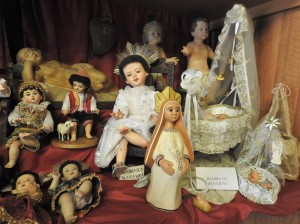 “The main aim of this museum is to share the sweetness of Christmas and the joy which is inherent in each statue of baby Jesus,” revealed the couple.
“The main aim of this museum is to share the sweetness of Christmas and the joy which is inherent in each statue of baby Jesus,” revealed the couple.However, this place offers much more than that since it nurtures love for one’s family, whilst it cherishes an appreciation for diversity. Undoubtedly, this collection is also an invaluable source for those who are interested to study the changes which took place along the years in the production of such precious artworks.
Il-Mużew tal-Bambini which is located at 17, Triq Santa Tereża, Birkirkara, will be open for the public from Sunday, 13th December 2015 to Wednesday, 6th January 2016.
Opening times: Monday to Saturday from 4:30pm – 8:00pm, Sundays and Public Holidays from 9:00am – noon and from 4:30pm – 8:00pm. For more information, one can call 21492111.
(This article was published in CHRISTMAS TIMES Suppliment issued with The Times of Malta dated 8th December 2015)
-
IN SICKNESS AND IN WEALTH
Although today, many societies relate marriage to two persons falling in love with each other, in the past, matters were quite different. Some of the local marriages, especially in wealthy families, were pre-arranged at age seven, in order to ensure that the children will marry a partner at par or even one which could enhance their title and possessions.
Parents were expected to provide their daughters with a dowry as a form of marriage payment and at times, as a kind of anticipated inheritance. Generally depending on the couples’ status and on the type of marriage contract which they adopted, this dowry could either serve to assist the newly-wed to establish a new household, or else to act as a mode of protection against the possibility of ill treatment to the bride by her husband and his family, since in the latter cases, the dowry might have to be returned back. A dowry offered also an element of financial security in widowhood, particularly if there were little children in the family.
The Notarial Archives in Valletta possess a treasure trove of stories connected to marriages and dowries of the past. Thick manuscripts with remarkably detailed records of people who lived hundreds of years ago, encapsulate these significant moments in the elegant writing in black ink and brings them back to life, each time someone opens the old pages and reads.
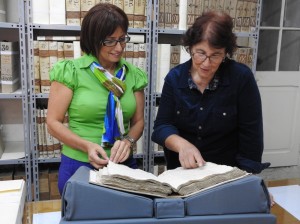 “One of the earliest contracts of marriages which one can find at these archives is dated to 1467. In it, Zullus Calleja from Naxxar is listing the objects which he is forwarding to the groom as a dowry in name of his daughter Jacoba. The form of this dowry is alla Maltese, and that means that the future husband will only be able to administer these possessions but not to sell them without his wife’s consent. However, once their children are born, this dowry will automatically be divided into three equal parts; one belonging to the husband, the other to the wife, and the rest to the offspring. Nevertheless, the children will not be able to utilize these belongings until they reach age 15,” revealed historian Dr Joan Abela.
“One of the earliest contracts of marriages which one can find at these archives is dated to 1467. In it, Zullus Calleja from Naxxar is listing the objects which he is forwarding to the groom as a dowry in name of his daughter Jacoba. The form of this dowry is alla Maltese, and that means that the future husband will only be able to administer these possessions but not to sell them without his wife’s consent. However, once their children are born, this dowry will automatically be divided into three equal parts; one belonging to the husband, the other to the wife, and the rest to the offspring. Nevertheless, the children will not be able to utilize these belongings until they reach age 15,” revealed historian Dr Joan Abela.Together with Isabelle Camilleri, a diligent worker at the Notarial Archives, Abela prepared a display of manuscripts pertaining to different eras so that I could analyze the interesting data within.
“Whilst I was doing some research about marriage contracts in the old days, I discovered that much of them included also a section marked as dos which related to the dowry being given by the father to the groom. Some of these dowries formed part of the inheritance of the bride and therefore it was declared in the contract that the amount which was being given to her during marriage, would be eventually decreased once she inherits her deceased parents. On the other hand, some contracts stated that this dowry was being donated over and above the future inheritance that the woman will have,” explained Abela.
This study shed light also on different types of dowry contracts which were in existence at the same time during various periods.
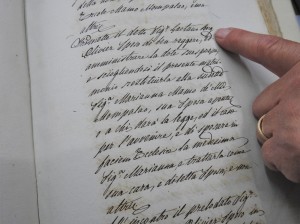 “The most popular ones were the contracts that used the alla Greca or the alla Romana custom, which were practically the same thing. Basically, this type of contract stipulated that all the dowry which was forwarded by the bride’s father to the groom could only be administered by the latter but it could never be alienated without his partner’s approval.”
“The most popular ones were the contracts that used the alla Greca or the alla Romana custom, which were practically the same thing. Basically, this type of contract stipulated that all the dowry which was forwarded by the bride’s father to the groom could only be administered by the latter but it could never be alienated without his partner’s approval.”No matter which style was chosen, all these dowry contracts were quite formal and organized. Experts in each sector of the items being included in the dowry were called upon to evaluate these objects professionally, and their names were included in the contract as a guarantee of genuinity. Ultimately, each of these things were described meticulously in the contract, together with their value at the time.
“Each time that I am working on a new manuscript, I am often delighted at the descriptions that I find. They are so rich in detail that I get the impression of seeing or touching the materials being mentioned, or of smelling the scents and perfumes of the objects in question. I find myself literally in another world as I delve through these pages and read the lists of things that this bride carried with her to her new home,” Camilleri said.
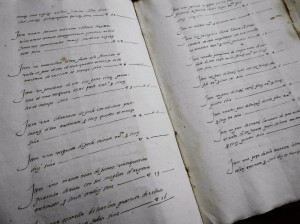 Dowries of affluent people could be quite impressive. One of these which was in the alla Romana style, had a list of more than 60 objects and was dated to 1557.
Dowries of affluent people could be quite impressive. One of these which was in the alla Romana style, had a list of more than 60 objects and was dated to 1557.“There is so much to ponder in this contract,” remarked Abela. “The one who was making the dowry was the renowned knight Marshall Fra Guglielmo Couppier who took part in the Great Siege of Malta in 1565. Interestingly, Victoria, the bride, had been Couppier’s slave but he had given her freedom. Moreover, in this contract, he was also forwarding a substantial dowry in her name, worth of a highly noble woman, to her future husband Hieronomu Debonè who worked as a bombardier and blacksmith.”
Victoria’s dowry included a 20 year old black male slave and a 59 year old female slave, refined jewelry made of gold, precious stones and pearls, clothes made from the most costly materials such as silk, velvet and wool, and mattresses, pillows, bedsheets and blankets of the finest luxury.
“Another type of dowry contract that was available was known as alla Latina. I didn’t find many of these and I noticed that generally they were used by peasants or families who were not so well-off. In fact, the main aim of such contracts was to help the couple initiate a new life together, since otherwise, this would have been difficult. The agreement in such contracts stated that after a year from their wedding, whatever the couple owned, including the dowry which the bride had brought with her, would belong to both of them. And once children were born, these possessions would be divided into three equal parts between the husband, wife and offsprings.”
Unlike the other types of dowry contracts wherein the husband was bound to return all the dowry objects to his wife’s father, in the same good state, or even better, should their marriage fail for any reason or if the woman died before having any children, the couple which chose the alla Latina contract shared both the good and bad times together.
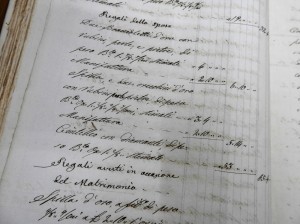 Camilleri led me to another manuscript which dated to the 1860 wherein she showed me a long contract that incorporated an inventory of the dowry of a woman who had died and left three small children behind. Her husband was going to get married a second time and so it was required to specify exactly the origin and value of the deceased wife’s possessions.
Camilleri led me to another manuscript which dated to the 1860 wherein she showed me a long contract that incorporated an inventory of the dowry of a woman who had died and left three small children behind. Her husband was going to get married a second time and so it was required to specify exactly the origin and value of the deceased wife’s possessions.“This dowry included also the gifts which she was given during her wedding,” highlighted Camilleri. “Jewelery made the best part of it and it comprised items made of gold, precious stones, pearls and diamonds. Who gives these gifts in weddings nowadays?”
Up to some years ago in Malta, dowries were still handed over to the newly married couple. Most of these couples were provided with practical items which would be useful in their new home, although some admit that they were given so many things that it was hardly possible to use all of them. In fact, a number of them were still lying in cupboards, brand new.
Although one might still encounter a few Maltese couples from the younger generation whose families are adamant to keep this custom alive, the tradition of providing a dowry of goods is certainly dying out. Yet I tend to believe that the dowry itself has not become obsolete but has merely changed form, possibly into money which could be used by the couple to buy a property or to finance their wedding reception.
(This article was published in the Weddings Supplement issued with The Times of Malta of November 4, 2015)
-
IF THESE WALLS COULD TALK
450 years ago, the Maltese Islands were in the spotlight of several European sovereigns after they had succeeded to come out victorious from the massive siege that was laid upon them by the powerful Ottoman Empire. Fort St Elmo lay in ruins and the other fortifications and houses which had been targeted by the enemy were in no better shape. The land still seeped in the blood of the thousands who had lost their lives during the fighting, whilst many others remained maimed.
Amid this devastation, the eminence of the surviving Knights of the Order of St John surged, and their fame reached legendary proportions. Letters of congratulations which they received from all over Europe, uplifted their spirits, whilst generous donations eventually helped them to build the new city of Valletta.
The Knights of St John continued to rule the Maltese Islands until 1798, when they were ousted by French Military General, Napoleon Bonaparte. Although, some might believe that at this time, the Order was obliterated, in reality, these mythical Hospitallers are still present amongst us, and are as real as ever.
The Russian Grand Priory of Malta
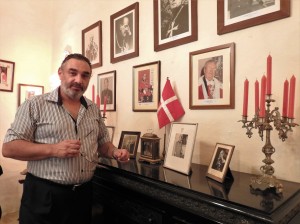 Since the early years of the Hospitallers’ foundation by Blessed Gerard, the Order protected the faithful and provided aid to the sick and poor. These elements have always remained deeply rooted in the mission of the knights who followed throughout the centuries.
Since the early years of the Hospitallers’ foundation by Blessed Gerard, the Order protected the faithful and provided aid to the sick and poor. These elements have always remained deeply rooted in the mission of the knights who followed throughout the centuries.“Even today, as Knights and Dames of the Russian Grand Priory of Malta who form part of the Order of St John of Jerusalem, Knights Hospitallers, under the constitution of the late King Peter II of Yugoslavia, we strive to continue to live up to our motto “Pro Fide, Pro Utilitate Hominum,” declared Chev. Saviour Garcia as we stood in front of a large painting of Blessed Gerard at Palazzino Sapienti in Valletta.
“Today, the Order’s mission still incorporates the duty to profess the Christian faith. However, its present members are not fighters but humanitarians who swear to act for the common good of all people without distinction of race or religion.”
Garcia outlined a number of philantropic projects which the Russian Grand Priory of Malta have been taking care of without much pomposity. Amongst these he mentioned St Joseph’s Residential Home for children in Żabbar, Dar Nazareth’s Residential Home for people with disability in Żejtun, and the construction of a hospital and a hostel in Thailand which caters for the needs of dying children with AIDS.
“The first investiture and the official institution of The Malta Priory took place on March 8, 1964. A few days after, His Majesty King Peter II of Yugoslavia legitimized the Order by giving it a new Constitution to meet 20th century demands. Within the first decades of its existence, The Malta Priory made several notable achievements which ultimately led it to be elevated to Grand Priory by Royal Warrant from King Peter II on Feb 22, 1970. This Royal Warrant gave our Grand Priory the name of Russian Grand Priory of Malta.”
Palazzino Sapienti, Valletta
 Interestingly, it was the same king who donated the sum of 1000 dollars in order to open a fund for the purchase of a large house which was expected to serve as the World Head Quarters of this Order. The choice fell on the prestigious Palazzino Sapienti which today is located at 223, St Paul Street, Valletta, right opposite to the University of Malta Valletta Campus.
Interestingly, it was the same king who donated the sum of 1000 dollars in order to open a fund for the purchase of a large house which was expected to serve as the World Head Quarters of this Order. The choice fell on the prestigious Palazzino Sapienti which today is located at 223, St Paul Street, Valletta, right opposite to the University of Malta Valletta Campus.An original letter held at the archives of Palazzino Sapienti that was sent to Czar Paul I by Grand Master Hompesch in 1797, indicates that at the time, the Russians had an interest to involve themselves in the Order. That is why, after the Knights of St John were expelled from Malta, some of them opted to find refuge in St Petersburg, where they elected the Russian Emperor, Paul I, as their Grand Master, thereby replacing Ferdinand von Hompesch who was then held in disgrace and had to abdicate in 1799.
Prior to its present distinguished function, Palazzino Sapienti had its fair share of interesting history.
“Whilst researching about the origins of this building, I discovered that its construction was commissioned in the late 16th century by the English Grand Prior of the Order of St. John, Sir Richard Shelley. However, he did not have the opportunity to enjoy his residence for long, since he got into disagreement with the Inquisitor after he failed to present to him his correspondence to the Protestant Queen Elizabeth for censorship, as was the regulation at the time. Soon, matters got worse when Shelley had also a dispute with Grand Master Peter del Monte, and in a diplomatic way, this building was taken away from him after he was offered another property. Instead, Palazzino Sapienti became the residence of Fra Nicolo Sollima, the Collegium Melitense Rector,” revealed Garcia.
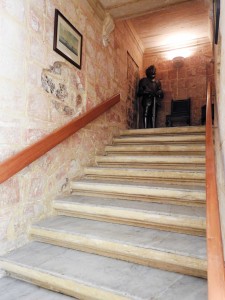 “Stone used for the building of the house was quarried on site. Once the building was complete, the resultant small quarry was used as a water cistern and basement. This process of cutting stones directly from Monte Sciberras hurried the process of the building of the new city.”
“Stone used for the building of the house was quarried on site. Once the building was complete, the resultant small quarry was used as a water cistern and basement. This process of cutting stones directly from Monte Sciberras hurried the process of the building of the new city.”“The facade of the palazzino was imposing, having a main door flanked by two others. The main entrance was decorated by a barrel vaulted ceiling, typical of the 16th century. Traces of a blocked arch located under the staircase which leads up to the piano nobile points out that originally, the level of the street was lower than it is today.”
“On 12th September 1634, a gunpowder magazine located in the whereabouts of the palazzino, blew up, killing 33 persons. The devastated site was left abandoned for thirty years until Grand Master Nicholas Cotoner established the Fondazione Cotoner in order to rebuild the houses in Strada San Paolo. The palazzino had suffered some cracks in the walls and its glass windows were shattered. Some structural changes were done to it, however, this structure was never intended to be built higher than two floors, since it would have been higher than the opposite building and would have cast a shadow on the University’s sundial.”
“Traces of red paint on the walls show that this building was painted in this colour. Meanwhile, the limestone balcony supports, the internal courtyard and the main staircase were adorned with seashell carvings that represented St John the Baptist, the patron saint of the Order of St. John. The seashell is also representative of the water element, in this case creativity and knowledge, as befits the University Rector’s house.”
It was a pleasure to explore this palazzino which I had never visited before. In the meantime, Garcia recounted some curiosities about the notable tenents who lived there.
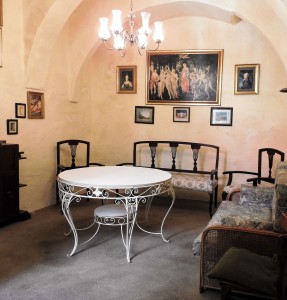 “In 1919, the tenant of Palazzino Sapienti was the lawyer Luigi Camilleri. On 7th June, 1919, Prince Lobanov-Rostovsky and Count Andrey Bobrinsky, both Russian Imperial refugees, were visiting Camilleri at his residence when suddenly the ‘Sette Guigno’ riots broke out. A large crowd made its way to the Royal Malta University and started to attack it, tearing down the English Imperial flag. These two Russian nobles who were witnessing this from the opposite palazzino were scared stiff since the remembrance of the Bolshevik revolution still haunted them. They stayed at the premises till the 12th June when they were escorted back to San Anton Palace in Balzan by Police Superintendent James Frendo Cumbo.”
“In 1919, the tenant of Palazzino Sapienti was the lawyer Luigi Camilleri. On 7th June, 1919, Prince Lobanov-Rostovsky and Count Andrey Bobrinsky, both Russian Imperial refugees, were visiting Camilleri at his residence when suddenly the ‘Sette Guigno’ riots broke out. A large crowd made its way to the Royal Malta University and started to attack it, tearing down the English Imperial flag. These two Russian nobles who were witnessing this from the opposite palazzino were scared stiff since the remembrance of the Bolshevik revolution still haunted them. They stayed at the premises till the 12th June when they were escorted back to San Anton Palace in Balzan by Police Superintendent James Frendo Cumbo.”“During the Second World War, the premises were used by the British Royal Air Force for the decoding of enemy aerial operations. Palazzino Sapienti survived two enemy bombs which were dropped in the vicinity. Yet tragedy still struck this place when two children, who were attending school in this building after the Valletta school was hit, found their way down a spiral staircase which led to the city’s undergrounds and got lost there. No one ever found them and these stairs have been blocked ever since.”
 Today, this building is also proud to possess three saint reliquaries: a first degree bone fragment from the Order’s Patron Saint St. John the Baptist, and two third degree relics in the form of a throne chair on which St. John Paul II sat during one of his Papal visits to Italy, and a hand signed dedication by Sister Mother Theresa of Calcutta who was also a member of the Order.
Today, this building is also proud to possess three saint reliquaries: a first degree bone fragment from the Order’s Patron Saint St. John the Baptist, and two third degree relics in the form of a throne chair on which St. John Paul II sat during one of his Papal visits to Italy, and a hand signed dedication by Sister Mother Theresa of Calcutta who was also a member of the Order.“Besides housing the Seat of the Order of St John of Jerusalem, Knight Hospitaller, Palazzino Sapienti has now opened its doors to the public who might be interested to visit it. Moreover lectures regarding various subjects are organized inside one of its rooms wherein we are also giving the opportunity to university students who would like to present talks about their studies or thesis.”
Certainly, an invitation to such a prestigious, architectural, and historical gem, should not be missed.
(This article was published in ‘Focus Valletta’ Suppliment issued with The Times of Malta dated 30 September 2015)
-
A SPECTACULAR WONDERLAND
Travelling at an impressive 300km/hr, a high-speed railway train took 5 hours and a half to reach Shanghai from Beijing. The voyage was impeccably comfortable. The train station was huge and amazing. Yet the actual surprise was the sheer difference between Beijing and Shanghai.
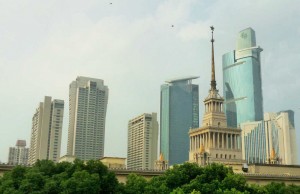 Traffic in Beijing was crazy but we had hardly left Shanghai’s train station when we were already blocked behind a long queue of cars. This is no wonder if one considers that about 24 million people live in this city. Recent modernization and progress in Shanghai have attracted many persons and in the last five years, the population tripled itself.
Traffic in Beijing was crazy but we had hardly left Shanghai’s train station when we were already blocked behind a long queue of cars. This is no wonder if one considers that about 24 million people live in this city. Recent modernization and progress in Shanghai have attracted many persons and in the last five years, the population tripled itself.Along the road, we observed that plain residential high rises were wide to an extreme. Besides them, luxurious or commercial high rises glistened beautifully as if in a bid to outshine the sun itself. Older traditional structures, together with buildings which formed part of the foreign concession areas, claimed the passers-by attention with their distinguished architecture.
Originally, a simple fishing village, Shanghai’s economy expanded rapidly once it was turned into a commercial port. Since at the time, traders could only use the sea or waterways as a means of transportation, Shanghai’s wide harbour began to attract numerous Chinese from various parts of China and also several foreigners. A society of immigrants started to flourish, each of which began to leave their influences in this new city.
In a few years, a large flat muddy area, overgrown with reeds, which was situated on the north bank of Huangpu River, was turned into a zone for foreigners and they named it the Bund. Starting from just a one-sided street, running in north-south direction, the location soon flourished with commercial buildings which increased further the significance and the economy of Shanghai.
 Yet in the mid-19th century, serious conflicts arose between the forces of Western countries and the Chinese, Qing dynasty, after China attempted to suppress the opium trade. Since the 18th century, foreign traders, particularly the British, had been illegally exporting opium which they imported from India. By the 19th century, this trade had grown dramatically, and the resulting widespread addiction in China began to cause serious social and economic disruption. Two Opium Wars broke out in which China was twice defeated and foreign concessions were established. It was in 1943, during the war between China and Japan, that the foreigners decided to abandon Shanghai.
Yet in the mid-19th century, serious conflicts arose between the forces of Western countries and the Chinese, Qing dynasty, after China attempted to suppress the opium trade. Since the 18th century, foreign traders, particularly the British, had been illegally exporting opium which they imported from India. By the 19th century, this trade had grown dramatically, and the resulting widespread addiction in China began to cause serious social and economic disruption. Two Opium Wars broke out in which China was twice defeated and foreign concessions were established. It was in 1943, during the war between China and Japan, that the foreigners decided to abandon Shanghai.Between the 1950s and the 1960s, some of the elder people who resided in Shanghai, proposed to the government to demolish these colonial buildings which reminded them of a bitter past. However eventually, it was decided to retain these structures since they represented a real part of the city’s history, even if painful.
 In the last 100 years, the Bund frontage buildings were repaired and reconstructed several times. Today, this area is embellished with prominent and elegant structures which contrast deeply with the opposite side of the Bund wherein some daring and bizarre high rises have been built. At night, the latter, turns into a spectacular wonderland as the colossal structures are fully illuminated in bright and colourful lights.
In the last 100 years, the Bund frontage buildings were repaired and reconstructed several times. Today, this area is embellished with prominent and elegant structures which contrast deeply with the opposite side of the Bund wherein some daring and bizarre high rises have been built. At night, the latter, turns into a spectacular wonderland as the colossal structures are fully illuminated in bright and colourful lights.A visit to this district which looks like a strange combination of London and New York, will reveal why it has become the symbol of Shanghai and the pride of many of its residents. Crowds of visitors gather daily at the Bund in order to enjoy the beautiful scenery on the Huangpu River which divides the old and the modern zones. Nonetheless, if one wants to enjoy the experience to the full, a night boat cruise is certainly recommended.
Our guide from Shanghai explained to us that this city has changed tremendously in these last years. In 1987, there were only 12 high rise buildings in Shanghai, whereas today, there are around 140,000. People have more money in their pockets, education facilities have increased, and life is more comfortable especially due to the efficient and far-reaching subway system. Yet he felt that simultaneously, Shanghai citizens were losing some important characteristics of the city. Indeed, when elders returned to the city after living far away, they could not find their way around as a number of the old landmarks have gone or are engulfed amongst the different modern landscape.
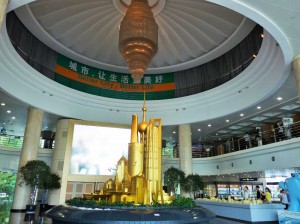 The repercussions of the sudden modernization of Shanghai have always been the focus of the authorities which are trying their very best to mitigate the impact of such changes. Their plans and projects are comprehensively described in the vast exhibitions which are displayed at the Shanghai Urban Planning Exhibition Hall which is located at the People’s Square. The centrepiece of the exhibition is a huge scale model of the city which shows all the existing and approved buildings. Moreover, a circular screen provides visitors with the opportunity to enjoy a fascinating 3D virtual tour around the city of Shanghai.
The repercussions of the sudden modernization of Shanghai have always been the focus of the authorities which are trying their very best to mitigate the impact of such changes. Their plans and projects are comprehensively described in the vast exhibitions which are displayed at the Shanghai Urban Planning Exhibition Hall which is located at the People’s Square. The centrepiece of the exhibition is a huge scale model of the city which shows all the existing and approved buildings. Moreover, a circular screen provides visitors with the opportunity to enjoy a fascinating 3D virtual tour around the city of Shanghai.Photo presentations explain how old buildings which were worth preserving and conserving, were carefully selected and restored, and then given a function in order to revive them. A particular example is the M50 contemporary art district which up to a few years ago was a disused industrial space. Another is the pedestrian walkway of Nanjing Road wherein 100 year old shops were amalgamated with new structures from where now, one can find speciality products of different trades standing next to famous brands.
 In Shanghai Old Street, which was reconstructed according to traditional Chinese style, visitors can roam around Yuyuan Market and absorb the allure of earlier times, whereas the nearby Yuyuan Gardens provide the beauty and serenity of a green environment. In the outskirts of Shanghai, ancient towns, such as Zhujiajiao, represent life of a distant and far simpler period in Shanghai. Concentrated under Shanghai’s Expo2010 motto ‘Better City, Better Life’, the main message of this place is to urge people to be proud as well as protective of their new city.
In Shanghai Old Street, which was reconstructed according to traditional Chinese style, visitors can roam around Yuyuan Market and absorb the allure of earlier times, whereas the nearby Yuyuan Gardens provide the beauty and serenity of a green environment. In the outskirts of Shanghai, ancient towns, such as Zhujiajiao, represent life of a distant and far simpler period in Shanghai. Concentrated under Shanghai’s Expo2010 motto ‘Better City, Better Life’, the main message of this place is to urge people to be proud as well as protective of their new city.A delightful wider look at the landscape of the city of Shanghai can be appreciated at a choice of revolving restaurants which are available on high towers. Definitely a surreal experience which gives you the ultimate impression of being on a totally different planet.
(This article was published in Escape Suppliment of The Sunday Times of Malta dated 13th September 2015)
-
Law of the sea
Amongst its various significant documents, the National Archives of Malta house the records of the Consolato del Mare di Malta within the premises of the Banca Giuratale in Mdina. This collection holds the first records of Malta’s own maritime tribunal and sheds light over more than 100 years of maritime laws that were effected between the late 17th century and the early 19th century.
 Consisting of a total of 473 items, the documentation of the Consolato del Mare di Malta is presently found in a stable condition. However it requires attention since present storage conditions do not guarantee its future preservation. While, highlighting the huge importance which this collection has to the better understanding of both local and international sea law, maritime historian, Dr Joan Abela, recently appealed for the preservation of this collection for posterity. Following this appeal, a group of individuals who are connected to the Maltese maritime industry, have joined forces in order to come up with an initiative to collect the required funds for this project.
Consisting of a total of 473 items, the documentation of the Consolato del Mare di Malta is presently found in a stable condition. However it requires attention since present storage conditions do not guarantee its future preservation. While, highlighting the huge importance which this collection has to the better understanding of both local and international sea law, maritime historian, Dr Joan Abela, recently appealed for the preservation of this collection for posterity. Following this appeal, a group of individuals who are connected to the Maltese maritime industry, have joined forces in order to come up with an initiative to collect the required funds for this project.“The proper preservation of our archives is always our main focus,” said national archivist and National Archives CEO, Charles Farrugia. “After consulting with our conservators, it was concluded that using the current resources, it would take us about 80 weeks in order to complete the first phase of preservation on the documents of the Consolato del Mare di Malta, and it would cost approximately €25,000.”
This initial work will involve the removal of acidic wrappers from the bundles of documents, cleaning of the bundles, the provision of new conservation grade covers and a condition assessment. Moreover, this collection will be stored in archival quality boxes that will serve for better protection and storage.
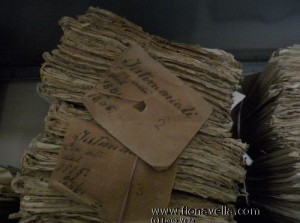 Archivist Noel D’Anastas commended the idea of this project, “At the moment, we have 52 metres of shelving dedicated to the collection of the Consolato del Mare di Malta. Although a good part of these documents are in a good condition, some of the bundles require urgent attention and it would be great if they could be preserved as soon as possible, particularly since this material is very much in demand by researchers.”
Archivist Noel D’Anastas commended the idea of this project, “At the moment, we have 52 metres of shelving dedicated to the collection of the Consolato del Mare di Malta. Although a good part of these documents are in a good condition, some of the bundles require urgent attention and it would be great if they could be preserved as soon as possible, particularly since this material is very much in demand by researchers.”The commercial court of the Consolato del Mare di Malta was established in 1697 and its main aim was to coordinate local maritime affairs and to tackle disputes and litigations in a more efficient way so as to facilitate trade. This arrangement was further enhanced by the appointment of experienced merchants in maritime trade in the positions of consuls for the tribunal of the Consolato.
“During the period of the Order of St John, corsairing became one of the major commercial activities of our islands. However, by the end of the 17th century, the politico-economic atmosphere of Malta had evolved into stronger commercial enterprises, thereby lessening the importance of the corso,” explained maritime historian Dr Joan Abela.
“Between the years 1721 to 1723, the corso employed around 700 men whereas circa 3000 men were engaged with the merchant fleet. Therefore the need for a new regulatory system must be observed in this wider context of change from a crusading order to a trading order.”
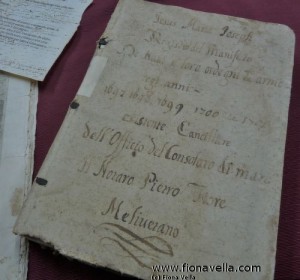 Till then, Maltese shipping had been administered by the Consolato del Mare laws of Messina and Barcelona. Yet this development created the requirement of a legal framework with which merchants and seafarers could be guided in their dealings with other traders and sellers.
Till then, Maltese shipping had been administered by the Consolato del Mare laws of Messina and Barcelona. Yet this development created the requirement of a legal framework with which merchants and seafarers could be guided in their dealings with other traders and sellers.In order to cater for this demand, Grand Master Ramon Perellos y Roccaful entrusted Fra Gaspare Carneiro with the task of studying the set up of the Consolato del Mare of various countries and particularly those which were used in Messina, Barcellona and Valencia. Thereafter, Carneiro was expected to compile and formulate the regulations for a Maltese Consolato law.
“From the documents that are held today, we can see that this maritime tribunal functioned for many years. In fact, this form of regulation continued to serve this sector until 1814; when the British eventually replaced it with the Corte di Commercio,” elaborated D’Anastas.
Asked about the relevance of this collection today, all three agreed that the study of such documents could enable researchers to understand the evolution of our local commercial trade within the broader Mediterranean context.
“Since law and custom were highly connected, such documentation could also reveal a number of local maritime customs. Furthermore, such a collection could divulge interesting details regarding the economic and social aspect of past societies, and how law and business functioned.” suggested Dr Abela.
“Indeed this collection of the Consolato del Mare di Malta provides a snapshot of various business practices such as the chartering of vessels, the wages of sailors, contracts of commenda or trade agreements made by captains, sailors or merchants, cases involving insurance, freight and trade networks, navigation techniques and many more valuable information. Therefore, its relevance for research applies to different areas of study,” remarked D’Anastas.
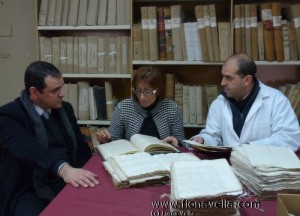 Once again, they all agreed about the benefit of preserving such documents which highlight how a particular system has succeeded to continue functioning and elaborating itself over such a long period of time.
Once again, they all agreed about the benefit of preserving such documents which highlight how a particular system has succeeded to continue functioning and elaborating itself over such a long period of time.“History is the foundation on which to build one’s present and future. A country which does not take adequate care of its archives tends to suffer from a sort of forgetfulness,” insisted Dr Abela. “I believe that such a collection should be regarded as a treasure of worldwide significance since its records can explain in detail how people from various countries managed to operate a system with which to work together like clockwork.”
“There is no boundary to how much one can expand in the research of such documentation,” concluded Mr Farrugia. “Likewise, there is no limit to the sort of preservation and conservation that one can apply to such a collection in order to protect it and make it available to future generations. Hopefully, one day, we will be able to digitalize this information so that this masterpiece of knowledge could be more easily shared on a wider scale.”
Sponsors who would like to donate funds for this venture are requested to contact jes@sullivanshipping.com.mt, bsultanasully@gmail.com, apmamo@gasanmamo.com, rpmiller@tugmalta.com, or call 2229 6165.
(This article was published in the Shipping and Logistics Supplement in The Times of Malta dated 18 March 2015)
-
A Traditional Crib
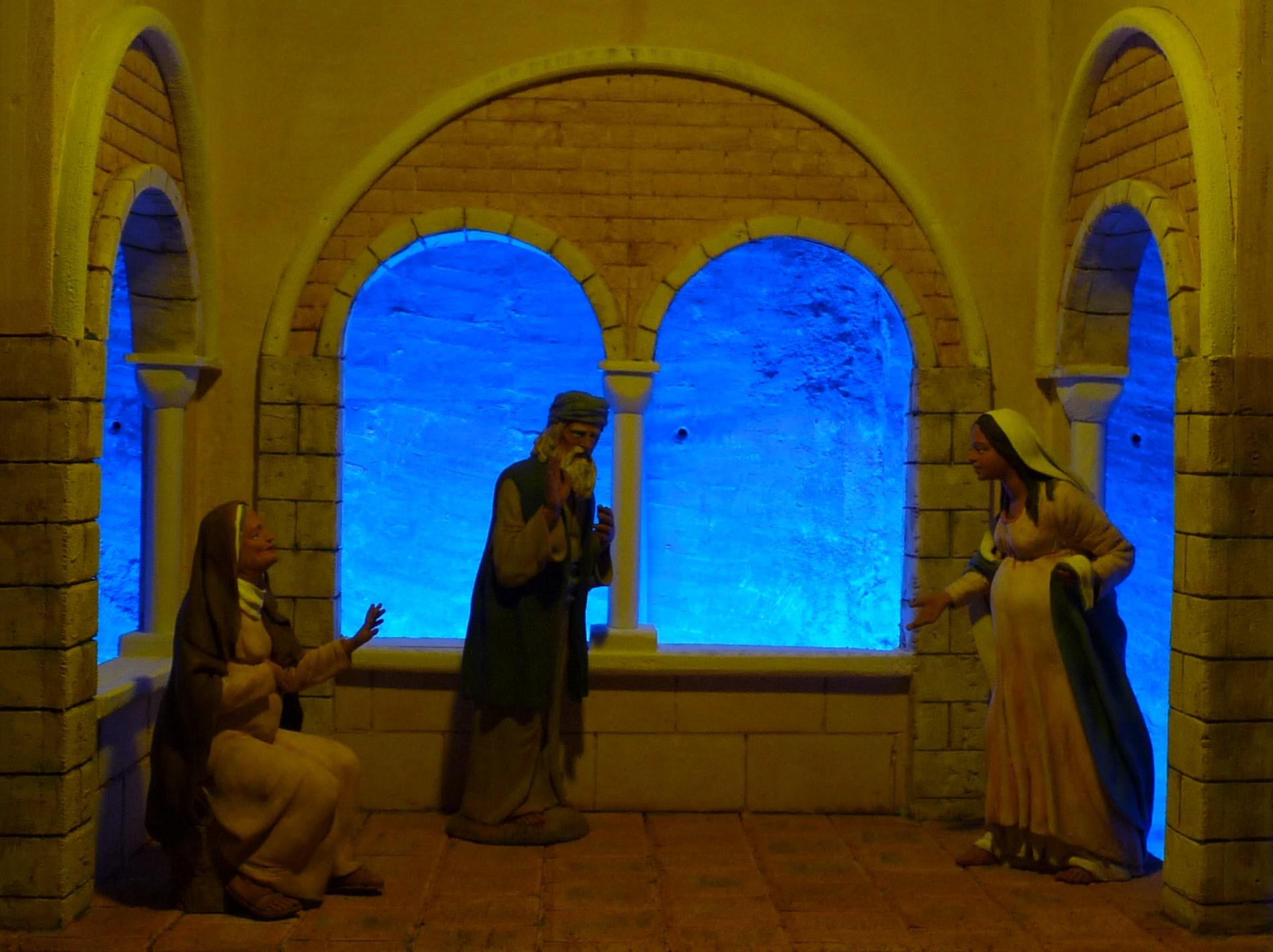
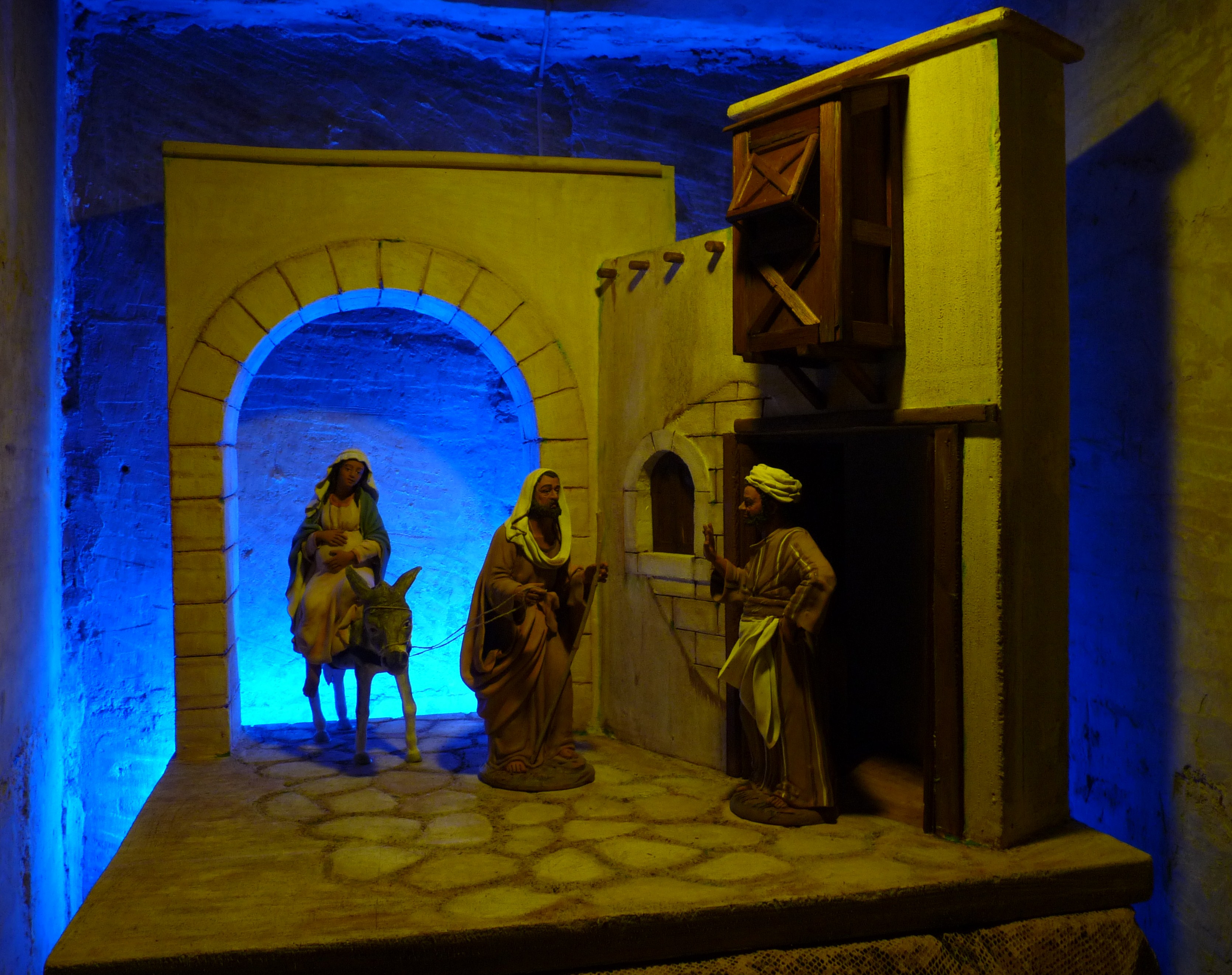
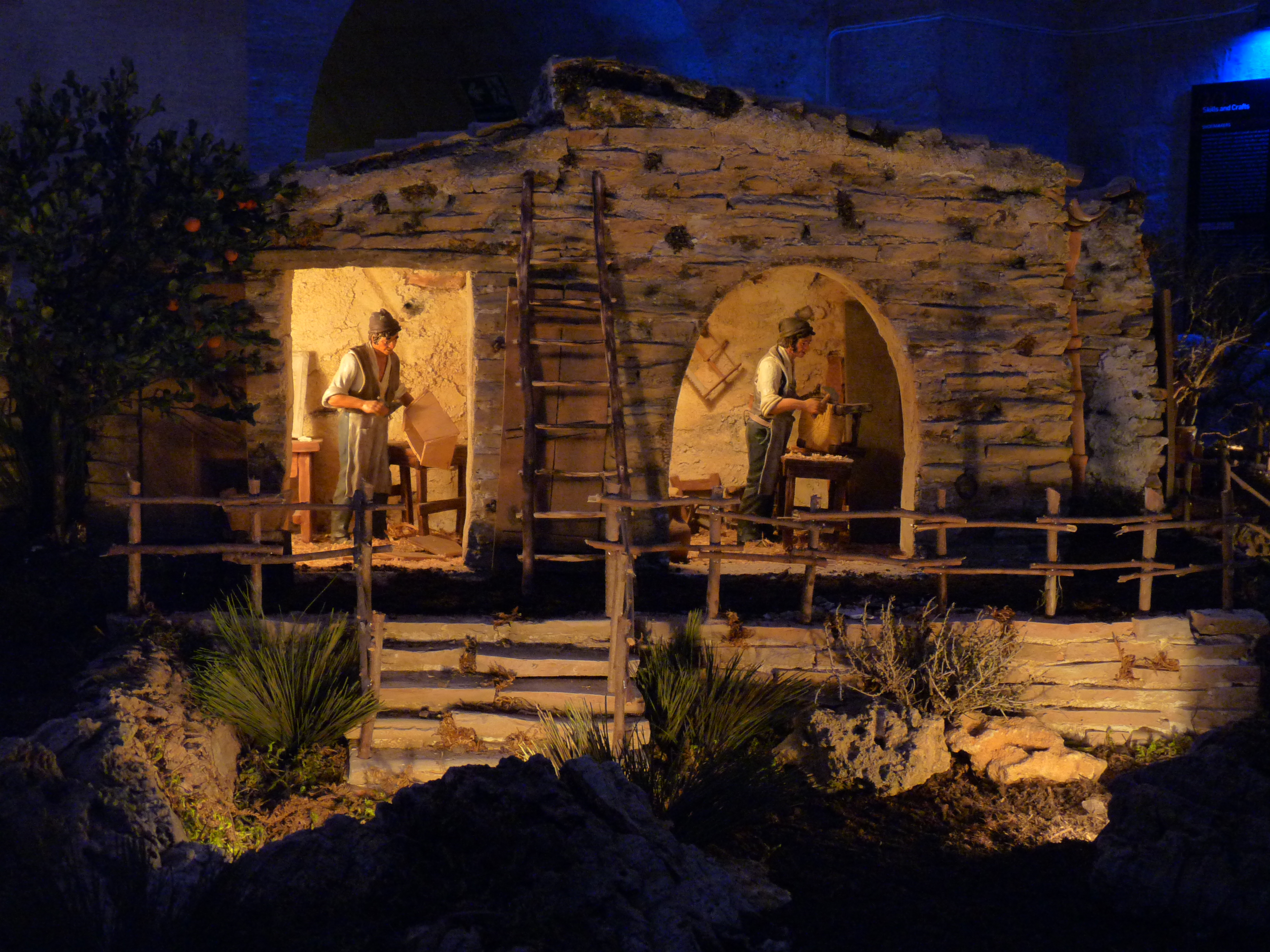
“The setting up of a crib during the Christmas season has become a worldwide tradition. However probably, few are aware that by doing this, they are reproducing a custom that was originated by St Francis D’Assisi in the 13th century,” told me Francesca Cannavò, the Curator of the Nativity Museum which is located in the crypt of St Augustine’s Church in Old Mint Street, Valletta.
“The main aim of this museum is to promote a deeper understanding and meaning regarding the nativity of Jesus and how this sacred event has been represented artistically during all these years by various artists,” explained Andrea Consalvo Rifici, the marketing manager.
Indeed, during these last months, the ambience of this huge crypt has been completely transformed into a landscape which instills the perception of being absorbed back in time, right to the period of this holy nativity.
“We want the visitors to walk around this place and to meditate about what was happenning in the days before baby Jesus was born and also what took place soon after.”
Various panels with interesting information accompany the visitors throughout this journey which takes them deep within the old crypt in search of the revelation of the Christmas story. Meanwhile, heavenly music engages the visitors and immerses them into the sanctity of this experience.
“In the old days, many of the people were uneducated and so they could not read the scriptures. Therefore, the Church set up various plays and commissioned many paintings in order to create a visual narrative with which the people could comprehend certain episodes in Jesus’ life.”
In fact, beautiful reproductions of renowned artistic works that portray the nativity scene compliment and enhance the significance of this museum, as the visitors can enjoy and absorb the different interpretations that were effected by remarkable painters such as Leonardo da Vinci, Giotto, Tiziano, Rubens, Botticelli, Carvaggio, Fra Angelico, and Hugo van der Goes.
“It is believed that these representations of the nativity have inspired St Francis of Assisi to compose the first crib which he set up in a cave. Eventually, this idea was so much appreciated by the people that they decided to produce their own cribs in order to possess the blessed nativity scene within their homes. As years passed, people continued to develop this concept by designing new ways of expressing this remarkable episode.”
A circular room within this crypt has been selected to present a set of artistic scenes which manifest the main events that are relative to the birth of Jesus; such as that of the Annunciation, the dream of Joseph, Mary’s visit to a pregnant elder Elizabeth, the search to find a place for Mary to give birth and the hasty escape to Egypt.
“These set ups have been designed in Sicily in order to decorate this museum. The figurines were made by Vincenzo Velardita in Caltagirone whereas the scenography was realized by Gigi Genovese in Catania. We tried to keep these scenes as simple as possible in order to reflect the modest nature that Jesus Himself chose for his own birthplace.”
Certainly, the principal attraction in this nativity museum is the huge crib with its numerous mechanical figures.
“This crib is the work of Salvatore Milazzo from Caltagirone. We are proud to say that it has been admired in several countries and that it has received various prestigious awards. This year, we decided to introduce it to Malta because we are aware that the Maltese people are deeply devoted to the nativity of Jesus. Moreover, we wanted to share our Sicilian culture with the Maltese people since there are many similarities between our culture and traditions.”
Milazzo’s work is definitely a work of art as it embraces within it all the skill of the renowned Caltagirone masters of this trade. The forty square metre crib has been decorated with a typical Sicilian country lansdcape of the 1800s which includes also a number of workshops of trades which do not exist any longer.
Meanwhile, this museum incorporates within it also a number of locally made cribs that were provided by members of Friends of the Crib (Malta).
Interestingly, this nativity museum which has opened its doors for the public in November will not close after the Christmas season and it will remain available to visitors all throughout the year.
“The concept behind the creation of this nativity museum in Malta is to heighten the experience of Valletta 2018 both to local and to foreign visitors, by blending together the culture of this island and that of Sicily.”
(This article was published in CHRISTMAS TIMES Magazine which was issued with The Times of Malta dated 13th December 2014)
-
A medal for silver
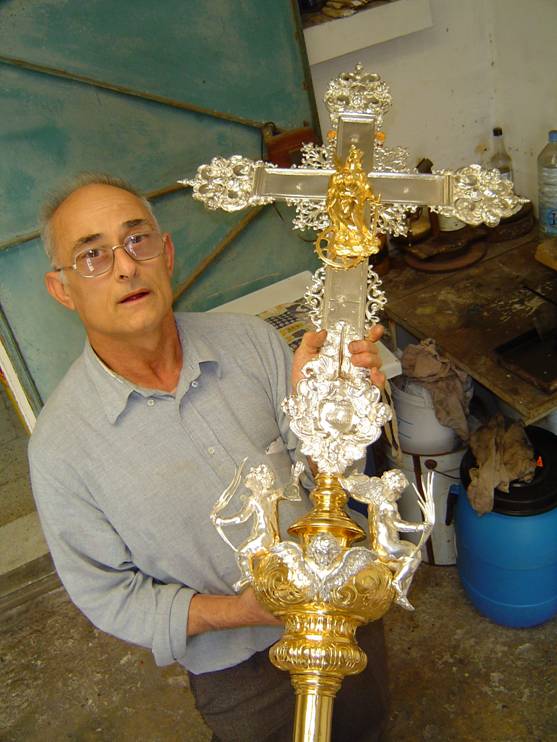
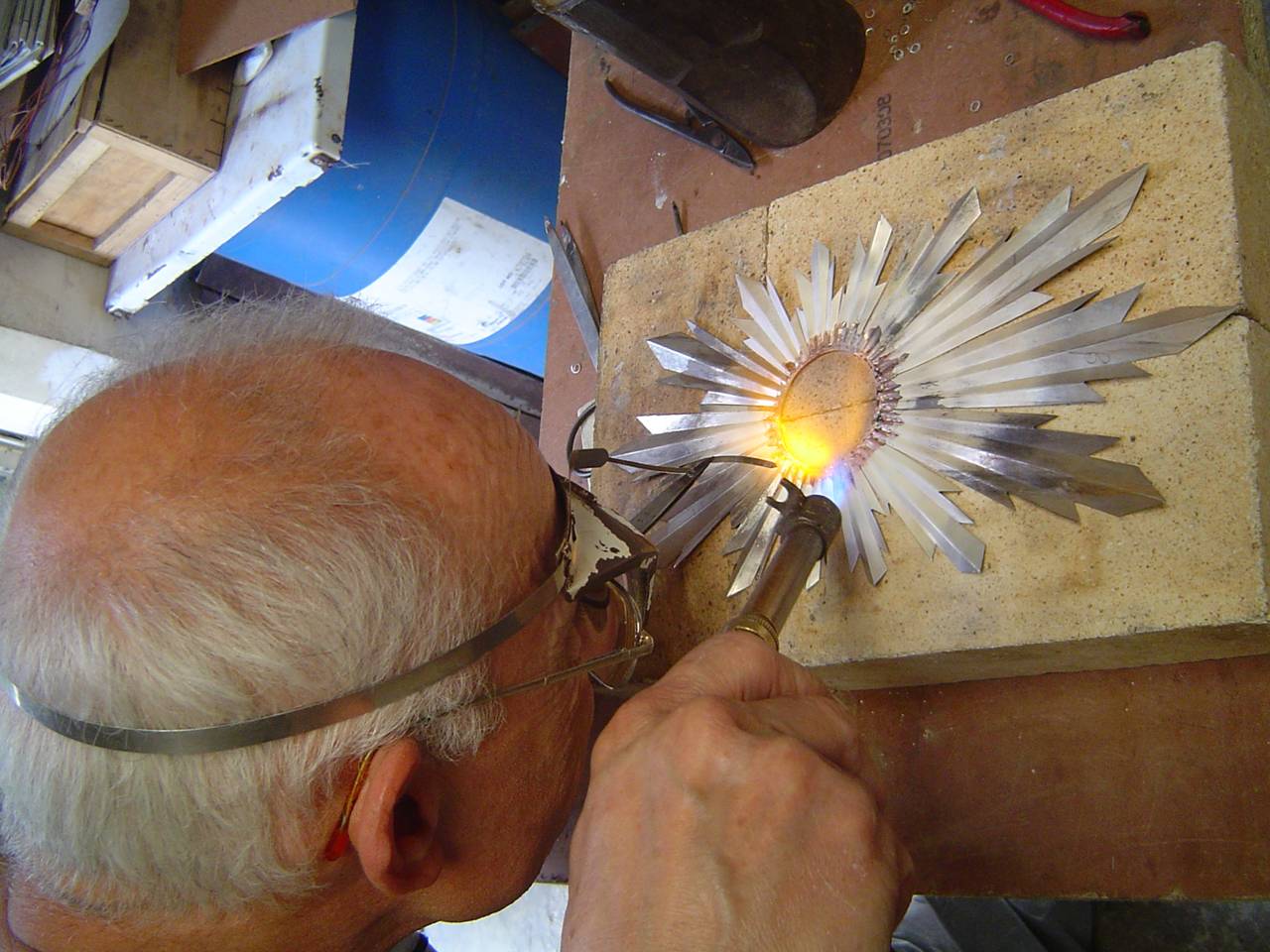
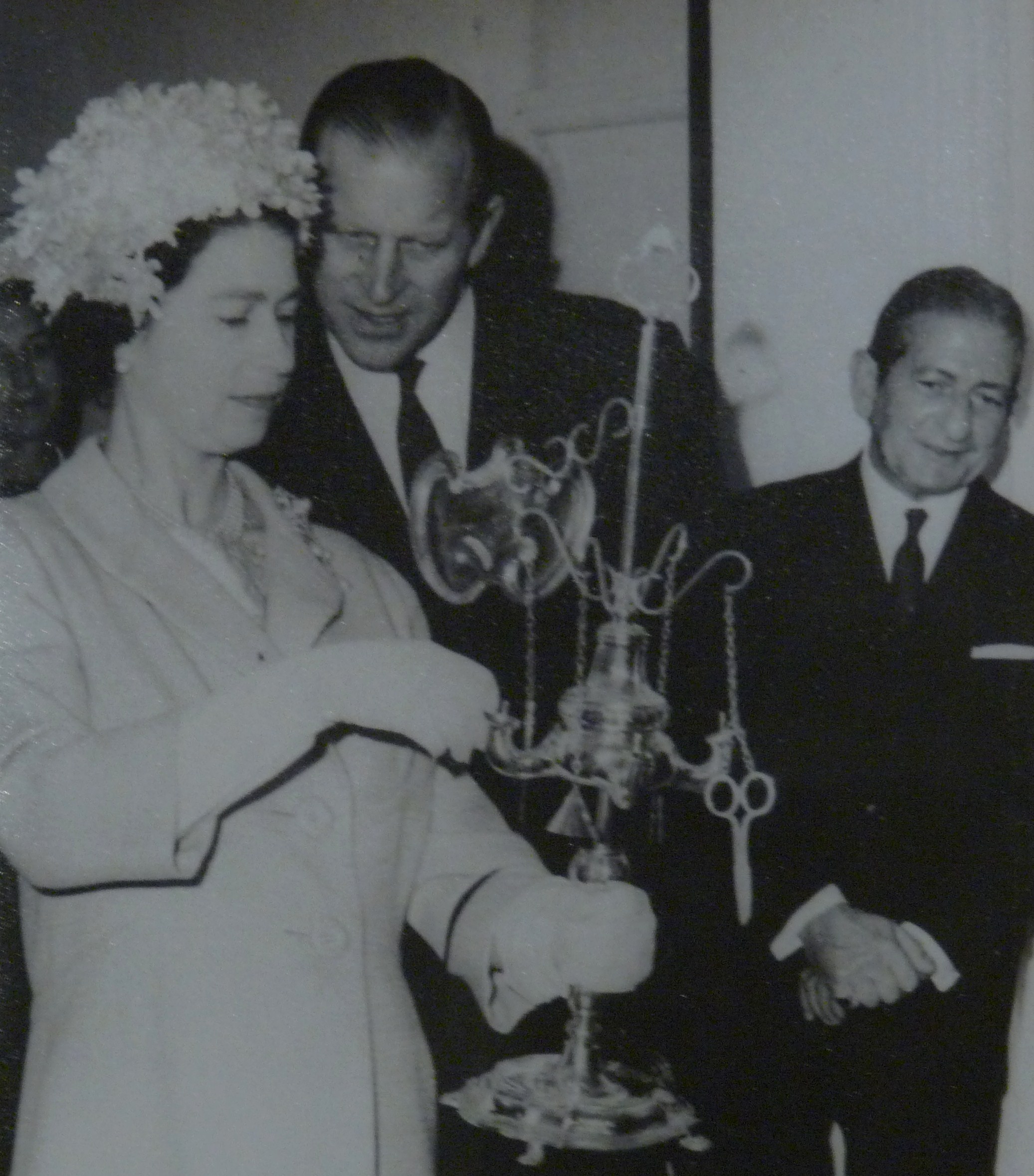
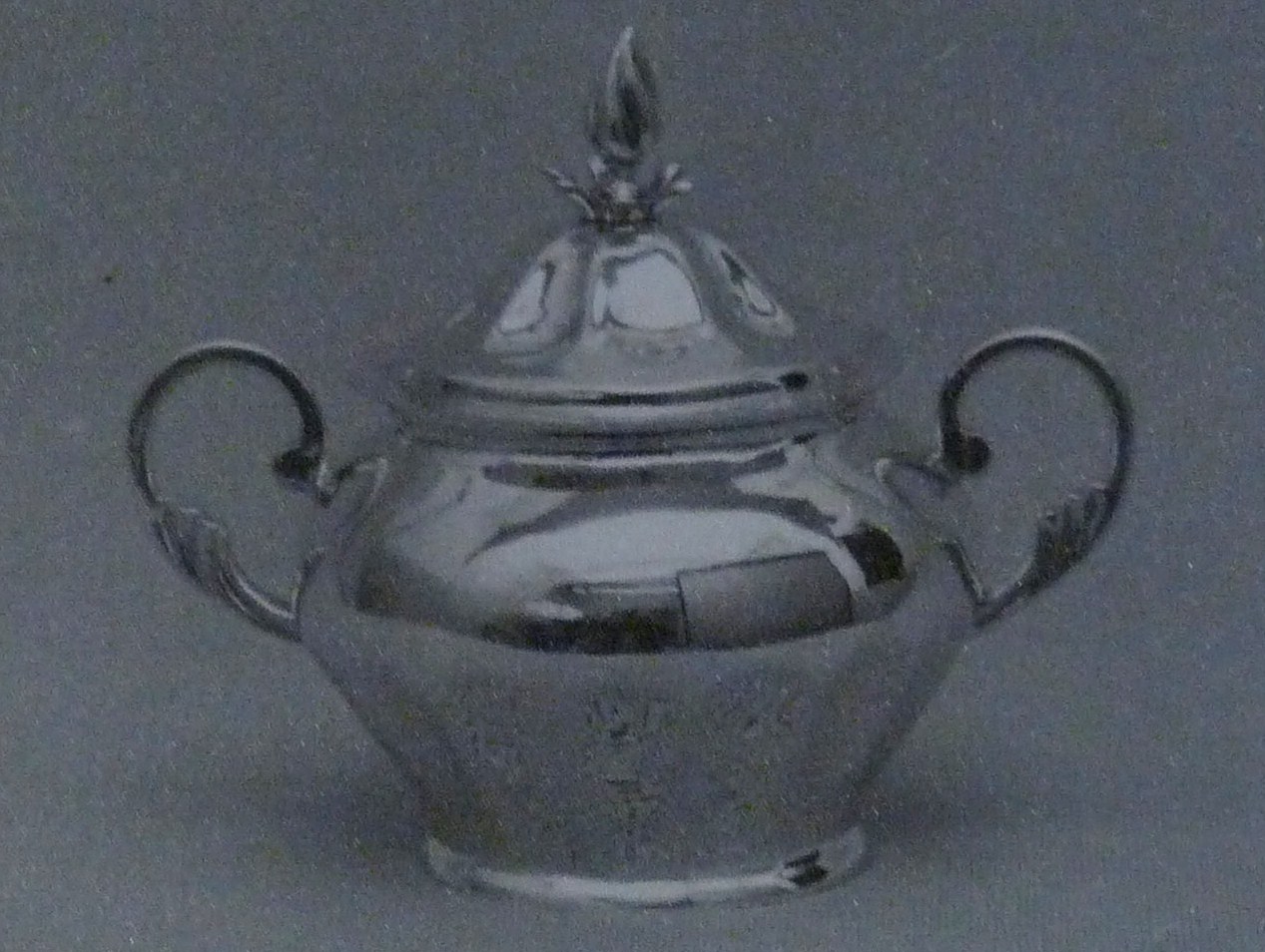
Within his small workshop in Zejtun, 68 year old silversmith Joseph Aquilina, can still do wonders with precious metals. Having worked as a silversmith from age 14, he has gained so much mastery in this trade that one of his creations was donated to Queen Elizabeth II during the celebrations of Malta’s Independence in 1964. Nowadays, his expertise is particularly focused on the restoration of antique objects which adorn our churches.
Aquilina learnt this trade from his father Joseph who was originally from Cospicua. Before World War II, Cospicua was renowned for some of the most skillfull silversmiths who eventually had to move to other areas in Malta when this zone became a target to heavy attacks and bombardments.
From early childhood, Aquilina was very interested in his father’s work and he spent hours observing him working silver items in his shop at St Mary Square in Zejtun. At age 12, he used to rush at the shop immediately after school in order to join silver beads together to produce rosaries for his father’s clients.
Aquilina knew that he was hooked to this trade but he never dreamt that at age 14, he would be obliged to choose between attending school and becoming a silversmith! It all happened when one day, a social service inspector called at their shop and found him doing some work. It was useless to insist that the boy was only helping his father because the inspector maintained that if the boy wanted to stay in the shop, he had to register for employment within 15 days. And that was the end of his schooldays.
“School meant nothing to me at that time and I thought that it was a great opportunity to start doing what I was really passionate about. However, when in later years I had to manage my business and was faced with several difficulties due to my brief education, I realized that leaving school at such an early age was definitely a huge mistake,” admitted Aquilina.
His father was greatly disciplined in his trade and he demanded the same diligence from his son. Above all, he wanted to pass to him all the knowledge that he had inherited from past generations. Yet this was no easy task since the silversmith’s trade expands vastly and covers areas which include work in silver, gold, filigree and the setting of diamonds.
“Nowadays, most silversmiths choose to specialize in just one of these sectors, but when I was learning the trade, one had to learn to deal with all these areas in order to become a professional. It took long years until you were regarded to be competent enough to open your own business. That was why it was necessary to start at a very young age in this trade and to take matters very seriously.”
Interestingly, Aquilina succeeded to attain his father’s complete trust by disobeying him.“My father expected utter attention during work, both because he wanted the final product to be impeccable, and also because the slightest mistake could be very costly, especially when we were using gold. He put so much pressure upon me that at first, I felt terrified of him and I did not dare to do anything which he did not ask for.”
Yet one day, Aquilina felt confident enough to try his luck by operating the soldering equipment which his father had adamantly prohibited him to use. Indeed, whilst his father went to church to attend a Lent sermon, Aquilina asked his mother to give him her gold wedding ring in order to cut it in half and reconstruct it again. His mother accepted without a second thought and Aquilina hurried to the workshop, broke the ring in two, switched on the gas, prepared the soldering equipment and trembling with excitement, he quickly joined the two parts together. He did such an excellent job that his mother could not identify any signs that her ring had been broken, and when she told her husband about this and he inspected the ring, a bright smile lit on his face. His son had finally made it!
From then on, Aquilina had his father’s complete respect and he started to produce his own creations for their clients. He had learnt this trade in the traditional way where everything was done by hand, and to keep in line with this method, he decided to focus on the antique style. This stratagem worked perfectly with those connoisseurs who appreciated refined local craftsmanship.
“I am proud to say that many of my works can be found among the collections of several local and foreign distinguished individuals. Most of my creations consisted of antique Maltese style coffee sets which included only three items: a coffee pot, a sugar-basin and a milk jug, since tea was not popular back then.”
Some of Aquilina’s works have often been selected to be given as gifts to foreign individuals.
“I made a particular silver sugar-basin for a group of Drydocks’ workers who wanted to give it to their British Admiral when he ended his job in Malta. Yet surely, the most popular item that I produced, was the 14 inch oil lamp which the Government of Malta ordered directly from me during the period of the 1970s and 1980s in order to consign it to the foreign delegations who visited our country.”
Meanwhile, even though throughout the years, there were many machines available which could ease the difficulty of the job and hurry the flow of work, Aquilina always refused to use them.
“That is the only way of keeping the profession’s prestige and the value of your creations,” Aquilina insisted. “When this type of work is done by machines, the product will loose all its significance because nothing can replace the creative fabrication of the human hand. A handmade product is unique because one can rarely create an object exactly like another. Contrarily, the very precision of objects which are executed by machines will simply turn them into ordinary copies.”
In order to design and work his particular creations, at times Aquilina had to manufacture his own tools. Yet apart from the ingeniousness required in order to assemble these devices, it was fascinating to know the stories behind the origin of some of the material.
“Look at these heavy hammers and feel how heavy they are,” he told me with a mischievous look as he brought them near. “I bet that no one would ever guess what they are made of until I tell them myself!”
Certainly, I did not have the slightest idea.
“These were some of the huge bolts that formed part of the ‘Angel Gabriel’; the Greek tanker which in 1969 got shipwrecked near the area of the ex-Jerma Palace Hotel in Marsascala. I obtained them when the ship was being broken down into pieces in order to clear the coast.”
Another curious fact about this trade is that whenever a new silversmith is authorized to start his/her business, he/she is given a personal stamp with which to mark each object that they make. This stamp will be unique and it cannot be transferred to another person. Therefore, each silversmith’s work can always be recognized, no matter how much time elapses.
In order to explain better, Aquilina referred to an old and rare book ‘The Goldsmiths of Malta and their Marks’ (1972) which was published by Chev Victor Fredrick Denaro; a pioneer in the study of ancient silver in Malta. In this book, one finds significant information about the ancient trade of silversmiths which goes back to the period of the Knights of St John. Meanwhile, this publication includes also all the local silversmiths’ stamps together with their relevant details; starting from the Knights period up to 1972.
“This book is very precious to me particularly because it helps me to identify the silversmiths of the antique objects which I work on. This will also determine the period of the objects’ manufacture with more precision, and thereby I can understand better which materials and which procedures were involved in its making,” explained Aquilina.
The restoration of antique metal objects requires high expertise and attention since one small mistake could ruin them completely. Indeed, in these last years Aquilina was responsible for the restoration of various treasured items which include: the restoration of the silver crown of the icon of the Madonna of Carafa that is located within the Co-Cathedral of St John in Valletta, the restoration of the silver leaves that form part of the decoration of the relic of St John the Baptist which is situated in the Museum of the same Co-Cathedral, and in the restoration of the sword of the titular statue of St Catherine in the Parish of Zejtun.
(This article was published in the ‘Art, Antiques and Restoration’ Supplement of The Times of Malta dated 12th November 2014)
-
A life of prayer
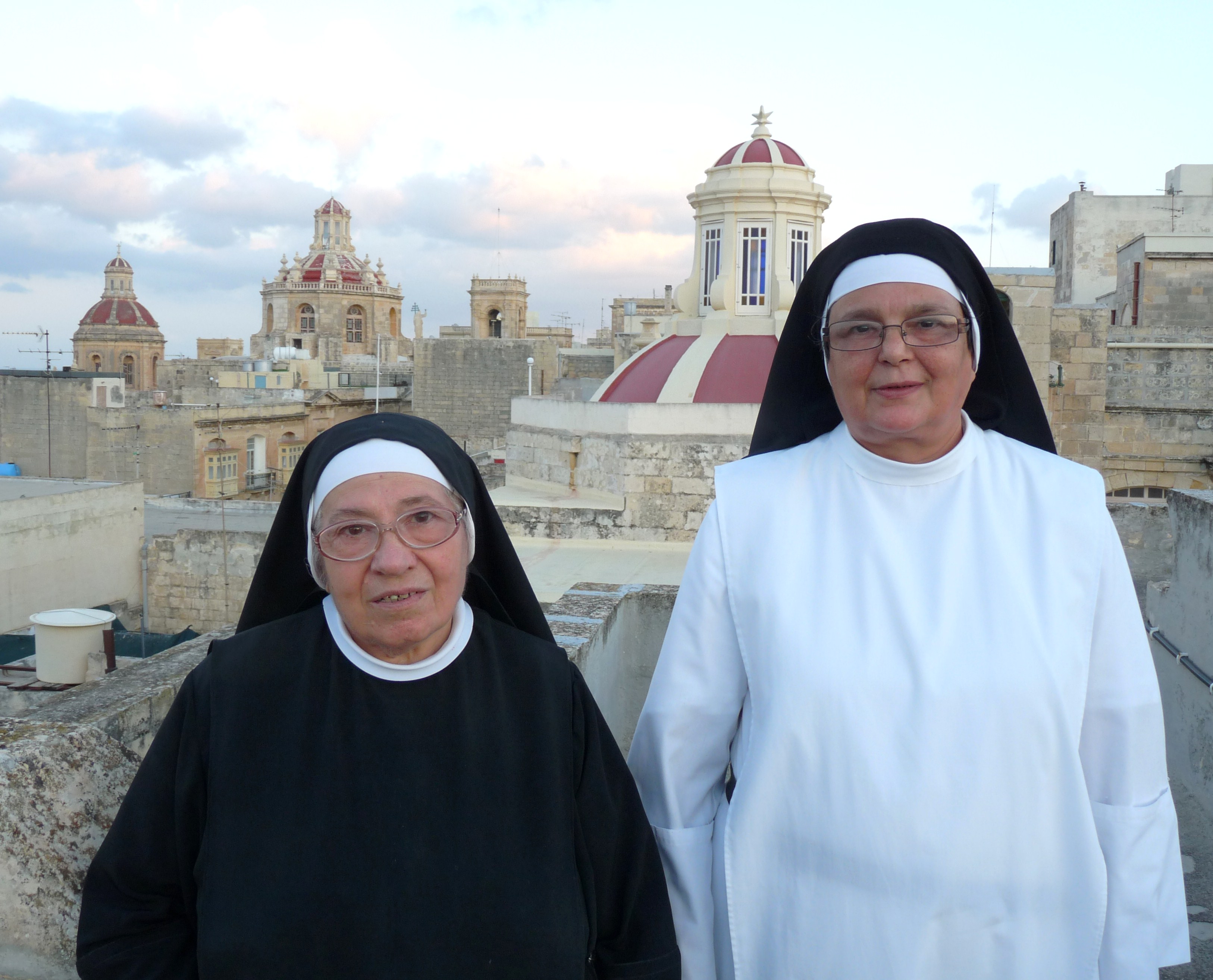

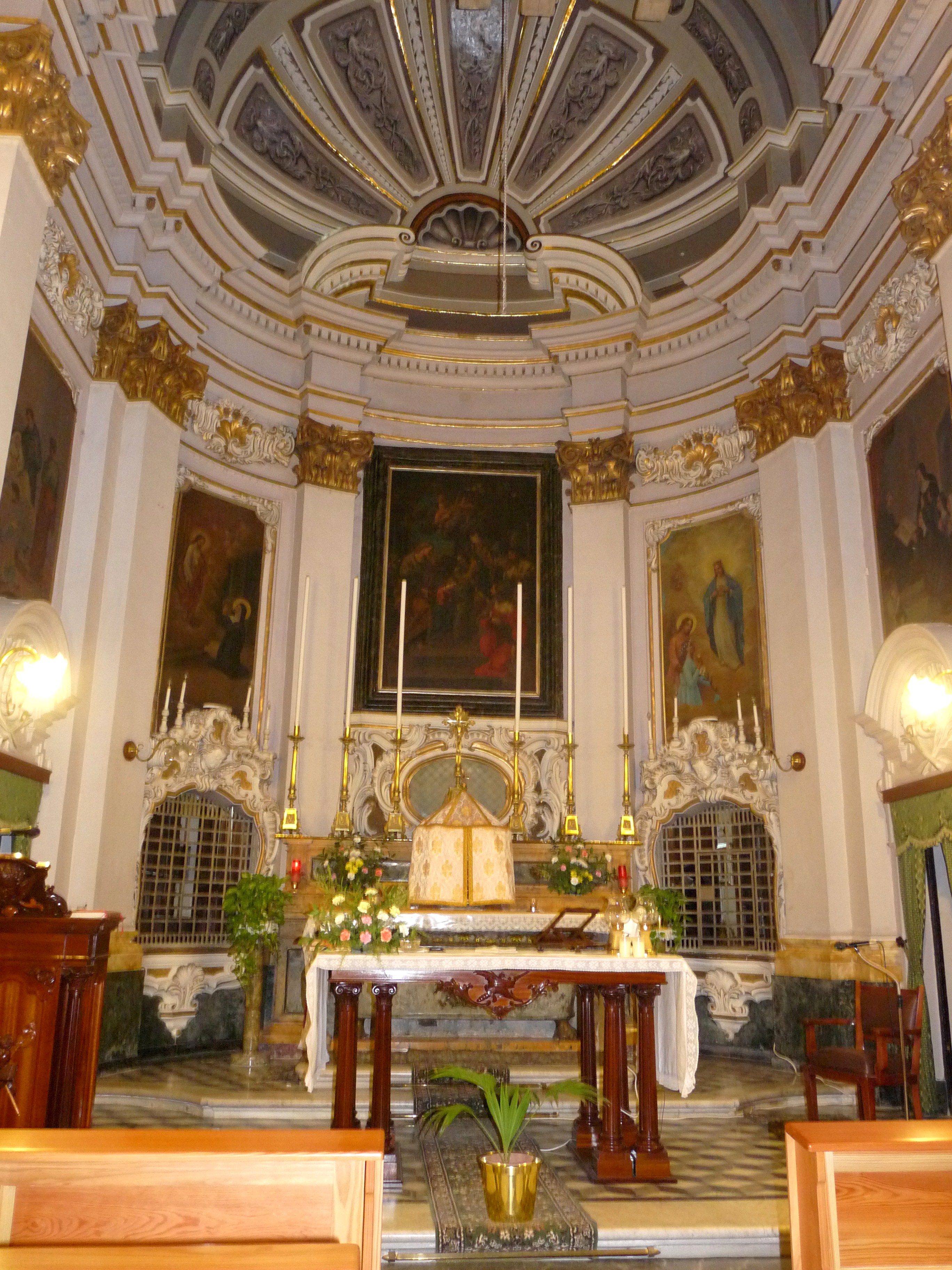
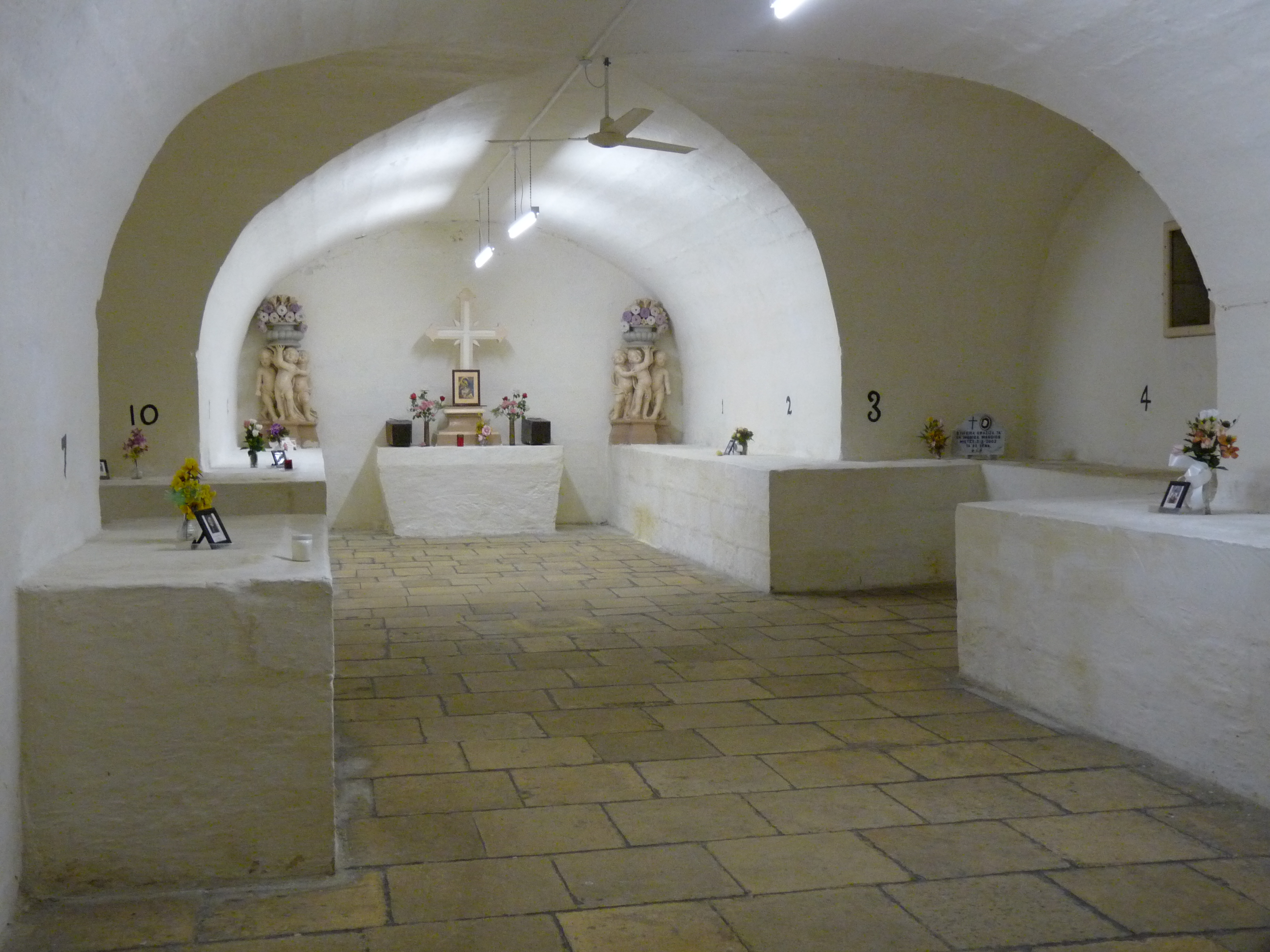
The concept of life as a cloistered nun has often intrigued people. How could one choose to deny oneself the privilege of freedom and instead opt for a life locked up in a monastery, when the rest of humanity dreaded even the thought of it?
As I knocked on the heavy door of the Monastery of the Augustinian Cloistered Nuns of St Catherine which is located in Republic Street, Valletta, I wondered how I was going to probe for an answer to this dilemma. Soon, a female voice responded from the intercom and when I identified myself, the door opened automatically and I stepped inside. The sight of three barred windows amid a thick white-washed wall bound me at a standstill and I stood there in silence and awe, unsure of what I was expected to do.
Indeed, I was quite surprised when Rev. Mother Abbess Sr. Michelina Mifsud called me in, for I had believed that this interview would take place behind bars and that I would never have the opportunity to look at her face.
“This would not have been possible if you had come to us about eight years ago,” responded Sr. Michelina as she read the question in my eyes. “At that time, you would have needed a special permit in order to contact us, and on your arrival, I would have sounded a bell so that all the other nuns would know that you’re here and they would retire to their rooms until you left.”
“Necessary communication with people used to take place only behind those bars,” she continued to explain. “We could neither read newspapers, nor hear the radio or watch television. Our lives were meant to be completely shut from the rest of the world so that we could focus only on God and our prayers. None of the nuns could get out of this monastery except when they needed aid for serious health reasons. We could not even visit our parents when they were sick and if they died, we were not allowed to attend their funeral. However, at times, our close family members could come to see us at the monastery and we greeted each other from behind the bars.”
I felt dumbfounded and looked down at the floor, searching for a way to question her how and why, until I could not resist no more and spoke out.
“This style of life does not make us feel miserable because this was our choice,” responded gently Sr. Aloisia Bajada who had joined us silently. “Our faith keeps us strong and prevents us from feeling depressed. Certainly there are moments when life gets pretty hard but whose does not? I am sure that even though you did not choose to become a cloistered nun, you too have to make several sacrifices for your family. So, you see, there is not so much difference between us.”
I watched them closely, trying to sense any strange move or reaction which might reveal a hint of unhappiness but instead I was met with sincere serene demeanour which was almost saintly.
“Sometimes even we find it difficult to understand and explain our vocation,” expanded the nuns. “We tend to regard it as a gift from God.”
We started to walk around the monastery and here I was in for another revelation. For the nuns did not live within some somber building but in a spacious and historical palace which was constructed during the period of the Knights of St John.
“This monastery has a long and interesting history,” told me Sr. Aloisia as she watched me admire the old paintings hanging on the walls, the colourful painted floor tiles and the exquisite architecture. “In my earlier years, it was my joy to delve within this monastery’s ancient archives which go back to 1606. They narrate detailed incidents and engaging stories which took place in this building and in the lives of the nuns that lived here hundreds of years ago. Surely, it is a pity that very few people have ever laid eyes upon them!”
At 88 years, Sr. Aloisia is the oldest of the remaining six nuns in this monastery. I was delighted by her passion towards the history of this place which has been her home for the last 70 years. As she led the way ahead, she informed me that originally this building was the residence of Marquis Giovanni and Katarina Vasco Oliviero, and it was known as Casa Vanilla. In 1576, this couple went through a rough time when their son contracted the plague, and in desperation, Katarina, who was a devotee of St Catherine, pledged to donate her house to the Church if her son survived. The boy did survive and Katarina was adamant to keep her word. However, when in 1611, she got to know of a group of girls known as ‘Orfanelle della Misericordia’ who had decided to become cloistered nuns and were taking care of children with family problems, she decided to give her property to them.
In order to change this palace into a monastery, the couple had to buy some of the neighbouring properties so that they could accommodate about 45 nuns, 15 girls and a chapel. This is why today, this monastery stretches out into Republic Street, St Christopher Street, Strait Street and also a section of St Dominic Street. Incidentally, within a year from their testament this noble couple died and since their son had already died before them, the cloistered nuns of St Catherine inherited all that remained.
By time, it became customary for some of the girls of the nobility to take their vows and join this monastery, and this included Grandmaster Manuel Pinto de Fonseca’s sister. Certainly, these girls brought with them generous dowries which supported a comfortable life. However, in 1714, the monastery required huge structural changes and much of the money ran out. Then, in 1798, when the French occupation took over Malta, the nuns found themselves in a dire state of poverty and they could not afford to take care of children any more. The number of nuns dwindled to eight but once the French left our islands, new nuns joined the monastery and life started afresh.
We entered into a lift which took us straight up to the monastery’s huge roof. A breath-taking view of the splendid architecture of the other Valletta buildings welcomed us and a fresh breeze whirled around us. The nearby wide blue sea was shiny and tempting, and we could see sea-gulls gliding smoothly over its surface.
“How can we feel restricted when we have all this to enjoy?” the two nuns asked me with a bright smile on their faces.
We stood together in silence, relishing the stillness and the beautiful environment which surrounded us. Then, the nuns shared with me what had led them to make this particular choice in life.
“Look down there,” asked me Sr. Aloisia as she indicated far below at the monastery’s garden which originally was the quarry from which the stone for this building was extracted. “During World War II, that garden suffered a direct hit and the nuns went to seek refuge at Ta’ Ċenċ in Gozo. I was 16 and from Xagħra and I did not even know what a cloistered nun was. One day, I saw some creative sewing which they had done and I felt curious to meet them. However, people told me that this was impossible, unless I wanted to join them. I felt terrified at the idea that they could keep me with them and yet finally some older friends accompanied me to see them and I liked the nuns’ company. As time went by, I continued to think about them and when I was 18, I was sure that I wanted to join those nuns who had in the meantime returned to their monastery in Malta. And here I am.”
“I was also 18 when I took my vows and became a cloistered nun of this monastery,” told me Sr. Michelina. “Ironically when I was younger, a priest who often watched me visiting and praying daily in front of St Rita, had suggested to me that I should consider becoming a nun and I was furious! Oh, I want to enjoy life, I told him. The life of a nun is not for me! However, some time later, he convinced me to meet the Rev. Mother Abbess of St Monica who in turn invited me to spend some weekends with them whenever I wanted. Somehow, I liked the idea and little by little I got very close to these nuns until I could not imagine any other life but to stay with them. Then, one day, I went to visit Frenċ tal-Għarb and without even knowing me, he made a cross upon my forehead with some oil that was blessed by the Virgin Mary and he told me that I would soon become a cloistered nun in the Monastery of St Catherine and that eventually I would die there. When I returned home to my father and told him about this, he swore that I would not withstand the life of a cloistered nun for more than 15 days. And yet here I am still after 51 years!”
We went down again and this time I was shown the crypt where all the cloistered nuns of this monastery get buried. Interestingly, in this crypt, one finds also the tomb of the son of the original owners of this building.
From there, we moved on to the small chapel wherein the nuns attend to pray. “After 1963, we received new regulations and many things changed. One of these included the possibility of receiving the public in our monastery, even if we still stand behind bars. Indeed, within these last years, many individuals have sought us for spiritual help and advice. Many more have chosen to join us during mass and so people have grown more accustomed to our presence and I think that their respect towards us has increased, now that they know us better,” told me Sr. Michelina.
“Through these encounters, we want to show people that life does not end when you become a cloistered nun. We simply start a new chapter of a life which is simpler and closer to God. We have our daily chores, we pray and help others, and we also enjoy developing our talents in sewing, crochet and art.”
“We miss absolutely nothing here except the need for more nuns to join us as we are too few now and most of us are also too old,” admitted Sr. Aloisia.
I cherished their warm hug when they embraced me before I left, and for a moment I felt a distinct sense of happinness. Yet once the monastery’s door closed behind me, I was concerned about how these nuns will live, once they will be too old to take care of each other? And what will be this monastery’s destiny if one day these nuns will all fade away?
(This article was published in Focus Valletta Supplement in The Times of Malta dated 1st October 2014)
-
The Grape South
In these last years we have been witnessing a major trend towards a return to one’s roots. Possibly we are realizing that the frenetic modern life is alienating us from the real meaning of what it means to be alive and from the significant feeling of belonging. Retracing ancestral footsteps often leads to a closer connection with nature and to a yearning to liaise directly with the land in order to breathe once again the fragrance of the soil blending in with the aromatic scents of plants, trees, fruits and flowers.
The Cauchi brothers have always looked forward to a visit to San Niklaw, their parents’ country residence and adjoining chapel dedicated to St Nicholas with its surrounding land on the outskirts of Żejtun. John, Thomas and Jeremy still remember the days when their grandmother used to bring them to San Niklaw to prepare the chapel for the pastoral visits by Archbishop Mikiel Gonzi. The boys were particularly attracted to the chapel’s bell and as soon as they were led in, they rushed to ring it at whatever time they could, even though their grandmother warned them not to as this gave a false impression to the neighbouring farming community that mass was about to begin.
On the other hand, the children were free to roam in the fields and to enjoy the wonder of exploring different areas in the stretch of land which has belonged to their family for centuries. They rambled around in search of anything of interest in this private space full of curiosities one of which is an authentic ‘qiegħa’; a circular structure which in the old days was used by farmers as a threshing floor to separate the wheat grain from the chaff by a donkey or ox pulling a stone roller.
Indeed, the last generation could do very little with the land since their careers had taken them on different ventures. However, once their father retired from work and could dedicate more time, the family started to discuss the possibility of enhancing the value of their estate and the surrounding environment by stimulating the dormant land to produce crops once again. Since none of them were farmers, they had to come out with a project which they could enjoy doing and which eventually they could get good at. Ultimately, their passion for good wines and food culminated in the idea of cultivating their own vines.
They began everything from scratch, kicking off this endeavour by attending to viticulture lectures. Meanwhile, they cleared the land from the wild vegetation and they prepared it for cultivation. They restored the weakened rubble walls and measured the land in order to plan the layout of the vines. Samples of soil were analysed to distinguish which type of root stock was ideal for their land. Once this information was obtained, they visited a foreign nursery and selected some of the best vine clones which promised to do well within San Niklaw Estate’s terroir.
This selection consisted of four types of root stock, each with their particular qualities. Vermentino vines have hardy leaves and are resilient to the south-east wind and to the salty sea-breeze which spreads to this zone from the nearby sea in Marsaxlokk. They produce a light-skinned wine grape which has a distinct luscious aroma of apples. Sangiovese vines are adaptable to many different types of vineyard soils. They produce red grapes which have the potential to turn into elegant wines with forceful flavours of strawberry and spice. Syrah vines’s produce is influenced by the climate in which they are grown and this will affect the style and flavour-profile of their wines. Indeed, these wines are renowned for their powerful and full-bodied characteristics which are derived from their dark-skinned grapes that give out strong aromas of blackberry, mint and black pepper. Mourvèdre vines are more capricious. They need very warm weather, a low leaf-to-fruit ratio and much more care, since they are susceptible to many viticulture hazards. However, their red grapes produce very interesting wines of a ruby colour and with unusual tartufo and earthly notes.
As the first leaves sprouted on the sowed branches, it seemed that the earth within San Niklaw Estate had accepted to support this new enterprise. Yet this was confirmed some months later when the initial small yield of grapes succeeded to produce a very satisfactory wine. Year after year, the Cauchi brothers developed their experience further and today, their skill at wine-making has flourished considerably. They have opted to use the philosophy of seeking out the best growing conditions for their vines and then let the wines make themselves.
As harvest time gets closer, a random sample of grapes is collected from the vines and the juice which is obtained will indicate the acidity and the sweetness of the vines’ produce for that year. When the grapes are finally ready for harvest, they are all picked within the same day. The white grapes’ stems are removed with a machine and then the grapes are squeezed. Only the white grape juice will go into the barrels. Contrastingly, red grapes are placed into the barrels with skin and all, after the stems have been eliminated. This is because in red grapes, it’s the skins that have all the color and flavour. Barrels made of French oak are used for San Niklaw’s Estate’s wine fermentation, and these are laid to rest within an old rocky cellar.
Three red and one white wine have eventually been produced by the Cauchi brothers and each one of them has its own particular characteristics. However it is the wine named Despatch which has the most fascinating story behind it. Indeed, the labels displayed on its bottles portray a ship bearing this name which in the 19th century belonged to the family and was used to transport cotton that was harvested from these fields in order to be traded in Marseille and Barcellona.
After this pleasant success, the Cauchi family has decided to extend this project into an activity of eno-tourism wherein visitors are welcomed to taste their products and to nibble at some freshly prepared traditional food. Interestingly, they have has also ventured to strengthen some other traditions, including the organization of the feast of St Nicholas which takes place on the 6th December. On this day, family members, friends, neighbours and people who get to know about this event, gather in front of a brightly lit and adorned chapel of St Nicholas and after the mass is celebrated, everyone gets an opportunity to taste San Niklaw Estate’s fine wines.
(This article was published in the Beer, Wine and Spirits Supplement of the Times of Malta of the 25th April 2014)
Technorati Tags: Fiona Vella,San Niklaw Estate,John Cauchi,Thomas Cauchi,Jeremy Cauchi,Żejtun,Archbishop Mikiel Gonzi,qiegħa,wine,winery,vines,Despatch,cotton,St Nicholas Chapel,eno-tourism -
Noble Stones
Edward Pullicino still remembers moments when as a young boy, whilst walking along one of the most prominent streets of Rabat, his late father Mario used to point out to him that Palazzo Castelletti belonged to their family. However, during that period, this historical building had been requisitioned by the government, and therefore the family could not enjoy its possession. Many of those who used this property made their own alterations to this old palace, at times even damaging it in the process, and Edward longed for the opportunity to reclaim it in order to restore it back to its glory. This aspiration became reality during these last years and today, a major part of this ancient gem has regained its splendour. Yet once again, Palazzo Castelletti was not destined to become a family residence. Instead, it has opened its doors to the public in order to serve as a stylish venue wherein one could relish this palace’s long and great legacy in Maltese history.
This palace was built in the 17th century as a private residence for the Theuma Castelletti family. Its distinct and prominent façade displaying the family’s intricate coat of arms, reflected the importance of its owners who formed part of the Maltese nobility. By the early 19th century, this building was extended further and this included the servants’ quarters. Apparently, some years later, this property was acquired by Baron Benedict Pisani Mompalao Cuzker, and the new residents of this palace were none other than the Blessed Maria Adeodata Pisani and her mother. The last landlord to live on the premises was Mgr. Prof. Carmelo Grima, an ancestor of the Pullicino family. He died in 1940 and from then on, the function of this building, alternated frequently as it passed from one hand to another.
In fact in 1941, this property was rented to the Nuns of St Joseph School, when they had to leave their premises in Paola, since it was taken over by the British Forces to be used as a hospital. When World War II broke out, these nuns decided to dig a shelter beneath the basement, with a separate exit on St Paul’s Street. Within it, the nuns and the students, together with some neighbours, used to take refuge during air raids. Once the war was over, these nuns returned to Paola, and between 1948 and 1958, Palazzo Casteletti was rented to L’Isle Adam Band Club and this place was turned into a social club. When this band club decided to move on the opposite side of the street, in Palazzo Xara, the Government of Malta requisitioned the building from its owners and divided it in two properties, namely 62 St Paul’s Street and 1 Old Doni Street. Part of the property was turned into government offices of the Social Services Department, whilst the other section was rented for private residence. In 1974, the Social Services Department left this building and the government seemed to be considering returning it to its owners. Edward’s parents, who were a freshly wedded couple, had in mind to occupy this palace as their private residence but their plans had to change when the government decided to split that part of the building into another two residences which were used for social housing. It was only in 2002, that the Pullicino family succeeded to recuperate part of Palazzo Castelletti, whilst the remaining section was acquired at a later stage, after the families that lived there were given alternative accommodations.
One would have imagined that after so many years during which the Pullicino family was negated the use of this palace, they would have opted to keep the premises for themselves. Yet, both because of the building’s spacious proportions and also due to the present trend where these historical places are being turned into commercial areas, the decision to turn this palace into a number of catering establishments was taken almost naturally.
Restoring the palace back to its original grandeur was not an easy task. Numerous alterations had taken place during the period when this property was used by third parties, including the building of further rooms in the courtyard, the division of large rooms into smaller ones, and the dismantling of some structures, including that of an old altar which was constructed during the years when Mgr Carmelo Grima had lived there. Luckily the latter was restored after it was found in pieces, together with a huge volume of rubbish and broken furniture, down in the old cellars which had been turned into a dumping site, though their original function was to store and ferment wine for the Castelletti family. The laborious work to remove this accumulation of trash eventually filled fifty loaded skips! Meanwhile, the additional structures were removed, whilst the authentic parts were restored, including the 20th century fountain stone statue of St Andrew which was sculpted by Luigi Muscat for Mgr Carmelo Grima in order to replace a pagan figure of Bacchus.
Great care was invested in identifying the original character of this place in order to respect its authenticity. Indeed, most of the rooms were repainted according to the colours which were retraced under the several layers of previous coatings, whereas a fresco which was painted by artist Mikiel Fsadni in the 1950’s was restored by Fr Charles Vella, revealing once again its rustic views of Maltese countryside and significant buildings that were adorned with intricate floral motifs and elaborate designs.
Interestingly, this restoration served to recover more than the original status of the palace itself, since during some structural works, it was discovered that the building rested on the remains of an ancient Roman village. After two years of archaeological excavations, this particular site revealed a section of a road of the Roman period, large ashlar blocks, some cisterns and channels, and a number of pottery, coins and jewelry. Most of the latter have been recovered by the Superintendence of Cultural Heritage but a very small selection of remains is available for public viewing, like this archaeological site itself.
The history of this era is vastly explained in a detailed exhibition which has been set up in the magnificently restored cellars that display an impressive series of interconnecting vaults which lie below the stately rooms of the palace. This exhibition is the work of Richard Azzopardi, a history enthusiast, who has researched in great depth the Roman era in Malta. Information panels provide interesting information related to Mdina and Rabat during this period, whereas a number of models portray his theories of how these places might have looked during this time. Moreover, this work also reveals an interesting finding of this researcher who has accessed various cellars in Mdina and Rabat, which areas have indicated that the original road in these zones during the Roman period lied at twelve feet below the present road-level. Indeed, this theory is supported by the archaeological site of the palace itself which shows that the excavated Roman road was situated within this calculated depth. This exhibition will remain open for viewing until September 2014.
(This article was published in the Property and Construction Supplement of the Times of Malta of 23rd April 2014)
Travelogue
Archives
| M | T | W | T | F | S | S |
|---|---|---|---|---|---|---|
| « Jan | ||||||
| 1 | 2 | 3 | 4 | 5 | ||
| 6 | 7 | 8 | 9 | 10 | 11 | 12 |
| 13 | 14 | 15 | 16 | 17 | 18 | 19 |
| 20 | 21 | 22 | 23 | 24 | 25 | 26 |
| 27 | 28 | 29 | 30 | 31 | ||
Recent Posts
- A MATTER OF FATE
- MALTA’S PREHISTORIC TREASURES
- THE MAGIC IS IN THE DETAIL
- THE SELLING GAME
- NEVER FORGOTTEN
- Ġrajjiet mhux mitmuma – 35 sena mit-Traġedja tal-Patrol Boat C23
- AN UNEXPECTED VISIT
- THE SISTERS OF THE CRIB
Comments
- Pauline Harkins on Novella – Li kieku stajt!
- admin on IL-KARNIVAL TRAĠIKU TAL-1823
- Albert on IL-KARNIVAL TRAĠIKU TAL-1823
- Martin Ratcliffe on Love in the time of war
- admin on 24 SENA ILU: IT-TRAĠEDJA TAL-PATROL BOAT C23

